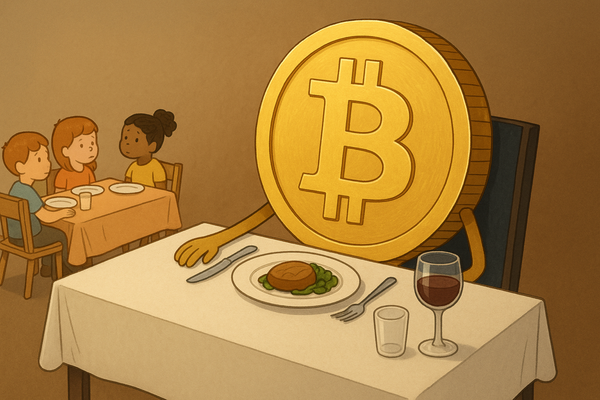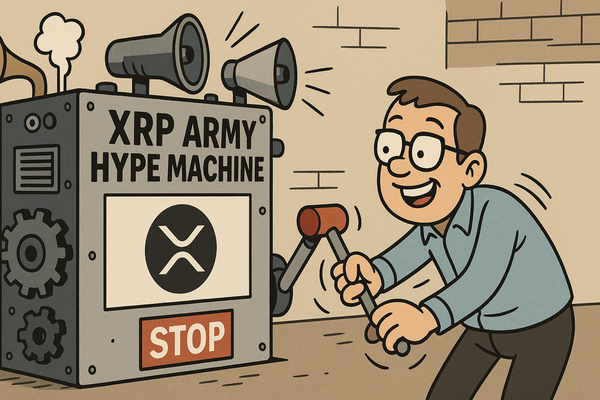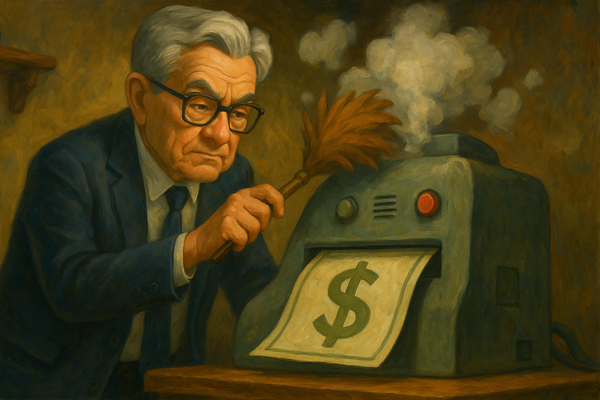Blockchain For Dummies: The Ledger That Changed Everything

Remember passing notes in class? That moment of panic when you saw the teacher walking down the aisle, eyeing the folded piece of paper being slipped from one desk to another. Why the secrecy? Why the trusted chain of custody from friend to friend?
Because information—who controls it, who sees it, who can change it—has always been about power.
Now imagine if, instead of passing that note secretly, you stood up and read it aloud to the entire class. Straight to the principal's office? Maybe. But also revolutionary in one critical way: once everyone heard that message, no one person could pretend it said something else.
But here's where it gets interesting—what if you could somehow read that note to the entire class using only code names? Everyone would hear the message—"Blue Eagle will meet Red Falcon at the rendezvous point on Saturday"—but nobody except Blue Eagle and Red Falcon would know who was actually meeting up or where.
That's the pseudonymous nature of blockchain. All the transactions are public (the note being read aloud), but they're tied to cryptic addresses rather than real identities (the code names). Everyone can see that "1A2b3C" sent 5 bitcoins to "4D5e6F," but nobody knows that it's actually your neighbor paying her dog walker—unless either of them chooses to reveal their identity.
This creates a fascinating paradox: a system that's simultaneously the most transparent ledger in history and yet offers a kind of privacy that traditional banking doesn't. Your bank knows exactly who you are and every financial move you make, while blockchain lets you operate behind a digital pseudonym.
Pretty revolutionary when you think about it.
The Problem with Trust (Or: Why Your Venmo Balance Isn't Actually Real)
Here's a strange truth about modern banking: when you check your balance online, you're not seeing your actual money. You're looking at an entry in a database that your bank controls. A database they could theoretically alter at any time.
Most of us don't think about this. We deposit our paychecks, swipe our cards, and trust that the numbers on the screen represent reality. And usually, they do.
But our financial system is built entirely on trust—trust that hasn't always been well-placed. Banks aren't just neutral record-keepers. They're profit-seeking entities that have sometimes acted against their customers' interests.
Remember 2008? When banks were packaging garbage loans as prime rib investments? Or that Wells Fargo fiasco where employees created millions of fake accounts while their customers were none the wiser? These weren't glitches—they were features of a system where we're forced to trust institutions that haven't exactly earned their gold stars in trustworthiness.
Even when your bank isn't being deliberately deceptive, they're definitely keeping secrets. Try asking your bank these simple questions:
- "Can I see every change ever made to my account balance?"
- "Can you prove mathematically that you didn't alter my records?"
- "Can I verify that your entire system's ledger is accurate without taking your word for it?"
The answer is no, no, and definitely no.
Enter The Blockchain: Truth By Consensus
It was October 2008. Lehman Brothers had just imploded. The global economy was in freefall. And while everyone was panicking about their 401(k)s turning into 201(k)s, someone using the name "Satoshi Nakamoto" dropped a nine-page PDF on an obscure cryptography mailing list.
Talk about bad timing. Or perfect timing, depending on how you look at it.
This paper wasn't written in the usual academic jargon that makes your eyes glaze over faster than C-SPAN at 3 AM. It proposed something radical: What if we ditched banks altogether?
The idea was simple but mind-bending: instead of one all-powerful bank maintaining your balance sheet, thousands of computers worldwide would keep identical copies. And they'd all constantly check each other's work like those annoying kids in math class who always pointed out when the teacher made calculation errors.
That's blockchain at its core: a shared record book that nobody controls, anybody can read, and once written, nobody can erase. Not your bank, not the government, not even that IT guy who somehow fixes everything by turning it off and on again.
Let me break this down using something we're all experts in: good old-fashioned gossip.
The Village Ledger: A Blockchain Bedtime Story
Picture a village where everyone gathers in the town square each evening. During these gatherings, anyone who conducted business that day announces their transactions to everyone:
"I bought three chickens from Sarah for ten silver coins."
"I paid Mike two gold pieces to repair my roof."
"I loaned Dave twenty copper pieces, to be repaid next month."
Everyone in the village writes down these transactions in their personal ledger. At the end of the meeting, they compare notes to ensure everyone recorded the same information. If someone's ledger doesn't match the consensus, they correct it.
Now imagine someone tries to pull a fast one:
"Hold up," says Jessica, flipping through her suspiciously fresh-looking ledger. "According to my records, I still have fifty gold pieces."
The villagers exchange glances, then pull out their own handwritten ledger notebooks. "Nice try," they say. "You blew forty-five gold pieces on that fancy horse yesterday. The one you've been parading around town all morning. You've got five left, and we all know it."
Jessica can't con the village because there's no single keeper of the truth—it's spread across dozens of independent records. That's blockchain's strength: a shared reality built on mathematics rather than trust in any single authority.
But How Does It Actually Work?
The village analogy is close, but blockchains operate in the digital realm with some critical differences:
** BUT FIRST: If you're the type of person who likes understanding things on a nerdy technical level like me read on... this part is for you... otherwise, feel free to skip this part, I won't get mad.
1. Blocks, Chains, and Cryptographic Puzzles
Transactions aren't recorded individually but bundled into "blocks." Each block contains:
- A batch of new transactions
- A timestamp
- A reference to the previous block (creating the "chain")
- The answer to a complex mathematical puzzle
That last part—the puzzle—is crucial. Before adding a new block, computers in the network (called "miners" in Bitcoin or "validators" in newer systems) must solve a computational problem that's hard to figure out but easy to verify once solved.
This process, called "Proof of Work" in Bitcoin's case, makes it incredibly difficult to alter past records. If you wanted to change a transaction from three blocks ago, you'd need to re-solve not just that block's puzzle, but all subsequent blocks' puzzles too—while competing against the entire network that's busy adding new blocks.
The security comes from the massive, decentralized nature of the network. Thousands of independent miners worldwide compete to validate transactions. To successfully attack Bitcoin, you'd need to control more computing power than the rest of the network combined—not just buying expensive hardware, but also finding enough electricity to power it and somehow doing it without anyone noticing your takeover attempt. It's theoretically possible but practically unfeasible, even for the most powerful entities.
2. Public Keys, Private Keys, and Digital Signatures
Remember our village scenario? In person, it's easy to verify who's who. Online, we need digital equivalents of identification and signatures.
Enter cryptography. When you create a blockchain wallet, you get:
- A public key (like your address, which you can share)
- A private key (like your password, which you must guard closely)
When you make a transaction, you "sign" it with your private key, creating a mathematical proof that you authorized the transaction without revealing your private key. Anyone can verify this signature using your public key.
If this sounds like magic, well, it's actually just really good math. The same math that keeps your online banking and encrypted messages secure.
3. Consensus: How the Network Agrees
Different blockchains use different methods to decide which version of the ledger is correct:
- Proof of Work (Bitcoin): Whoever solves the computational puzzle first gets to add the next block.
- Proof of Stake (Ethereum and others): Validators are selected based on how much cryptocurrency they've "staked" (essentially deposited as collateral).
- Delegated Proof of Stake, Practical Byzantine Fault Tolerance, Proof of Authority... the list goes on, each with its own tradeoffs between security, speed, and decentralization.
Beyond Currency: Smart Contracts and the New Internet
Bitcoin introduced blockchain as digital cash without middlemen, but Ethereum took things further by adding "smart contracts"—self-executing agreements written directly in code.
This transformed blockchain from a glorified checkbook into something more like a global computer that can run applications.
Consider these possibilities:
- Insurance that pays out automatically when flight data shows your plane was delayed
- Music royalties flowing instantly to artists when their songs get played
- Supply chains where you can actually track your coffee beans from farm to cup
Smart contracts eliminate middlemen and guesswork. No more wondering if the insurance company will actually pay up or if that "ethically sourced" label means anything. The code executes exactly as written, open for anyone to inspect.
The Limitations: It's Not All Digital Sunshine
Before you rush off to convert your life savings to crypto, let's talk about some serious limitations:
Energy Consumption
Bitcoin's computing network uses more electricity than Argentina. Not a typo. An entire country. This environmental impact is massive, though newer systems like Proof of Stake use a fraction of the energy.
The Oracle Problem
Blockchains only know what's on the blockchain. Once you need real-world information (like whether your flight was actually delayed), you're back to trusting external data sources—"oracles" in crypto-speak. There are some decentralized solutions that address this problem in some novel ways including things like $LINK and consensus resolution on prediction markets.
Scalability Headaches
Major blockchains process anywhere from 7 transactions per second (Bitcoin) to about 65,000 (Solana). For comparison, Visa handles around 24,000. This bottleneck has created a whole ecosystem of "Layer 2" solutions trying to make blockchains faster without sacrificing security.
User Experience
Let's face it: using blockchain stuff today feels like using the internet in 1995—clunky and intimidating. Lose your private key? Your money's gone forever. Send crypto to the wrong address? Tough luck, no customer service line to call.
So... Is Blockchain the Future?
Simple answer… Yes.
Once you understand the revolutionary benefits decentralized blockchains bring to the world it becomes a pandora's box that simply can't be closed. But here's the thing—the killer blockchain apps of tomorrow won't have "BLOCKCHAIN INSIDE!" stamped on them like some knockoff Intel processor. People won't know or care about the distributed ledger humming in the background. Just like nobody sends a text thinking, "Gee, I sure am grateful for TCP/IP protocols right now!" They'll just notice that fewer middlemen are taking a cut, fewer platforms are hoarding their data, and fewer suits are deciding who gets access to what.
The Village Square Goes Global
One last thought about that village square.
Today's internet is like thousands of separate villages. Each has its own set of books, its own rules, and its own gatekeepers deciding who gets to participate.
Truly decentralized tokens and blockchains hint at something different—one global village square where people trade directly with each other, where the rules apply to everyone equally (even the powerful), and where the history books can't be rewritten by whoever's currently in charge. At least that's my hope.
Too idealistic? Probably. Building this system faces enormous technical hurdles and fierce resistance from those who benefit from the current setup.
But the core idea remains powerful: we can use math, networks, and incentives to create systems where trust doesn't depend on blind faith in institutions, but on processes anyone can verify.
Next time you send money through your bank app, take a second to think about all the invisible databases tracking your financial existence. Then imagine those records made transparent, unchangeable, and maintained by everyone—not just the folks in the corner office.
That's what blockchain offers. Not just a tech upgrade, but a fundamental rethinking of how we establish truth in the digital age.
And in a world where facts themselves seem increasingly slippery, that might be what matters most.
WANT TO LEARN MORE? LET'S TALK!
I manage a private crypto fund that works with accredited and institutional investors. If you’re considering exposure for your portfolio, looking to learn more, or exploring strategic partnerships as an allocator or advisor, I'd love to connect!
🚀 Send me an email or a message on LinkedIn.
Disclaimer: The information provided in this blog is for informational and educational purposes only and should not be considered financial, investment, or legal advice. Do your own research and consult a professional—your money, your responsibility.




